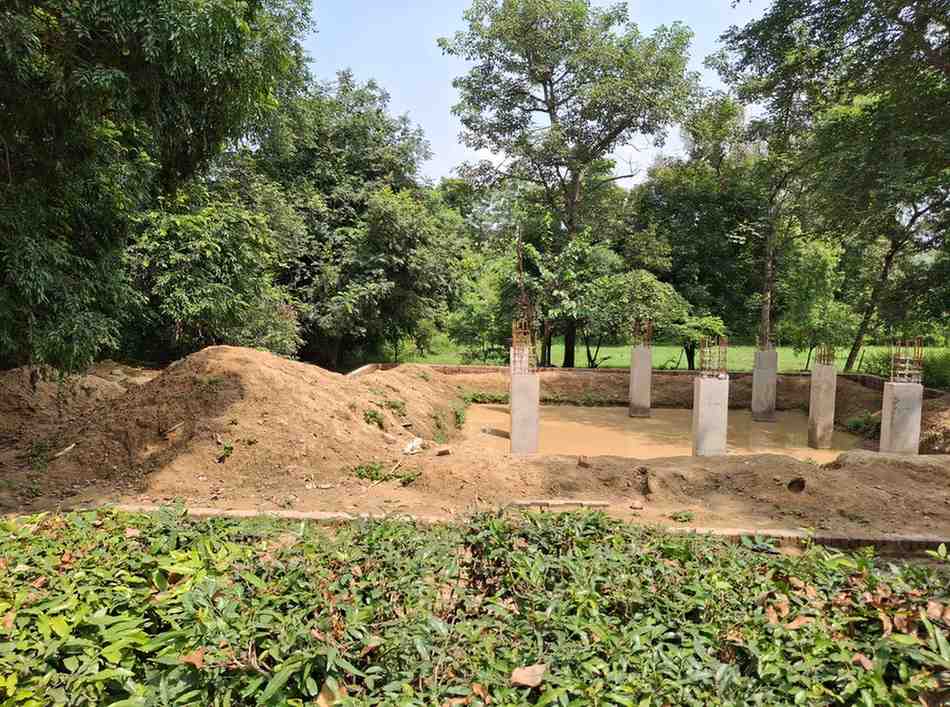Pic by Mukul Pandya
Talking Point
Brij Khandelwal
Senior journalist and environmentalist
Agra is once again watching a slow-motion environmental murder. Shahjahan Park—the 90-acre green lung between the Taj Mahal and Agra Fort—is being gutted under the pretty-sounding label of Sanskriti Van. Old trees, some a century old, are being suffocated. Butterfly habitats are vanishing. Grasslands are being dug up to make way for kiosks and concrete walkways.
The irony is painful. The city that houses one of the world’s most iconic monuments is now hacking away at its own protective shield. First, the Metro Project chewed up large portions of this park and spat out a lifeless parking lot. Now, the Agra Development Authority (ADA) is pushing another “heritage park” that reeks of commercial greed and bureaucratic arrogance.
A park turned into a playground for contractors
ADA claims it is “redeveloping” Shahjahan Park into a thematic heritage park. The list of planned features reads like a contractor’s shopping list: Miniature replicas of monuments, smart poles, sound systems, dustbins, gazebos, kiosks, paved walkways. All of this inside the 500-meter radius of the Taj Mahal—where the Archaeological Survey of India (ASI) and even the Supreme Court clearly prohibit new construction.
The official excuse is that the park will serve as a “green connector” between the Taj Mahal and Agra Fort. But green is the last thing this project represents. By ADA’s own admission, this is a tourism-centric project. Which means concrete, crowds, commercial stalls, and chaos—all in a space that was supposed to act as an environmental buffer. The project’s origin story is equally suspect. It appears to be a recycled version of an old World Bank–funded “Heritage Walkway” plan from 2016–2018. That project was quietly shelved, officially marked “closed”. Yet, somehow, the corpse of that idea has been resurrected, twisted into a commercial venture.
Rule-breaking as policy
The illegality is glaring. ASI rules bar construction within 500 meters of the Taj. The Supreme Court has repeatedly stressed that this buffer zone must remain untouched to protect the fragile environment around the monument. Yet construction is underway. How? Because when state governments wave a green flag, local objections are bulldozed. The Garden Department has already lodged protests, pointing out ecological damage. Environmentalists have raised alarms. But ADA hides behind political approval. Once again, democracy is reduced to a rubber stamp from Lucknow while Agra pays the price.
Ecological vandalism
The worst part is the irreversible damage. Trenches are being dug dangerously close to the roots of century-old trees. Natural grasses that support insects and butterflies are being destroyed. The park was home to countless species of birds and pollinators. All gone, for the sake of a few kiosks and lighting poles.
During the Metro project, we already saw what happens. Trees were cut, some transplanted, and most died. That patch of the park is now a heat-radiating parking lot. Concrete has replaced shade. The so-called development has worsened the city’s microclimate. The same fate now awaits the rest of Shahjahan Park.
And let’s not forget—the ADA has not even sought the mandatory Supreme Court clearance for tree felling. No proper accounting has been given of the Metro trees that vanished. Who benefits from this silence? Contractors. Vendors. Politicians are eager to cut ribbons.
Development or betrayal?
The language of “Sanskriti Van” is a cruel joke. Culture is not nurtured by kiosks and plastic benches. Heritage is not honored by fake replicas of monuments. And ecology is not preserved by turning a park into a carnival ground. This is not development. It is betrayal—of Agra’s citizens, of the city’s ecology, and of the Taj Mahal itself. The Taj is more than marble and minarets. It needs the living green shield of trees, grass, and open space around it. Strip that away, and you strip away the monument’s soul.
A call to action
Shahjahan Park must not be allowed to die quietly. Citizens, environmental groups, and heritage lovers must unite. Legal petitions must be filed. The courts must be reminded that rules exist for a reason. Agra has already lost too much green cover to Metro lines, highways, and parking lots. Enough is enough. The message needs to be clear: development does not mean destruction. Planting a few saplings cannot replace the cooling, carbon-absorbing power of century-old trees. Tourism profits cannot justify ecological collapse. And state governments cannot bulldoze citizens’ rights in the name of progress.
If this project is not stopped, Agra’s last great park will become just another concrete theme zone. The city’s green lungs will collapse. And even the beauty of the Taj Mahal—dependent on the air and light around it—will be at risk. Agra cannot afford more arrogance disguised as development. Shahjahan Park is not just another plot of land. It is a living heritage, a natural fortification for the Taj, and the city’s last hope for ecological balance. The time for polite objections is over. The time for action is now.
















Leave a comment